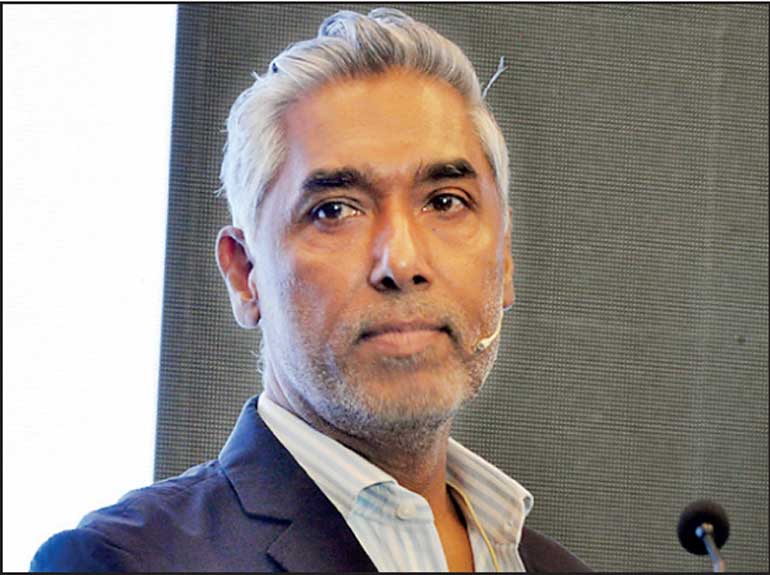Tuesday Apr 08, 2025
Tuesday Apr 08, 2025
Wednesday, 13 November 2024 00:00 - - {{hitsCtrl.values.hits}}

Visionary Motherland Director
V. Sunil – Pic by Lasantha Kumara
By Charumini de Silva
The visionary behind India’s successful ‘Incredible India’ campaign V. Sunil last week opined that Sri Lanka should explore on building a brand with a multi-dimensional approach that extends beyond scenic attractions, focusing instead on an experience-driven narrative that resonates with the interest of travellers.
Speaking at the first-ever South Asian Tourism Leadership Forum of the Sri Lanka Design Festival 2024, he suggested that Sri Lanka Tourism can draw lessons from the ‘Incredible India’ campaign.
With his experience in transforming India into a global tourism brand, Sunil said building a cohesive tourism brand requires consistency and alignment across the Government, tourism bodies, and businesses.
“This integrated messaging approach was essential to the success of ‘Incredible India’ and could similarly benefit Sri Lanka by presenting a unified vision of the island. The goal should be to harmonise marketing, infrastructure, and service quality to support a clear and compelling narrative that resonates with tourists and sets Sri Lanka apart from other regional destinations,” he explained.
The luxury tourist, he noted, often seeks more than just beautiful landscapes; they want immersive experiences that blend cultural richness, personal growth, and high standards of hospitality.
“For Sri Lanka, this means presenting a tourism proposition that goes deeper, highlighting its rich heritage, culinary diversity, artistic history, and vibrant local culture. By positioning itself as a destination that caters to this desire for meaningful engagement, Sri Lanka can shift its image from a relaxation spot to a place that offers holistic, enriching adventures,” he suggested.
Sunil also noted that at present, tastes of Indian luxury travellers are increasingly aligning with those of high-end European and American tourists, with a growing focus on exclusivity, sustainability, and storytelling.
“This overlap allows Sri Lanka to craft experiences on the rise; Sri Lanka can carve out a niche by offering tailored, luxury-driven options that showcase the island’s natural and cultural diversity – from exclusive wildlife safaris to private culinary tours and art-centric retreats,” he explained.
Sunil was of the view that Sri Lanka’s tourism could benefit from an approach that integrates multiple industries — particularly those rooted in culture, design, and craftsmanship.
“As Sri Lanka seeks to strengthen its appeal to the high-end tourism market, the country can create a unique cultural ecosystem that adds depth to the travel experience. This approach must align with luxury travellers’ interests in sustainability and authenticity,” he said.
He said that partnerships across sectors, including hotels, cultural venues, and event organisers, could help build a consistent narrative that brings these elements to life, creating a distinctive ‘brand Sri Lanka’ that emphasises the sophistication and substance behind its tourism offerings.
Discover Kapruka, the leading online shopping platform in Sri Lanka, where you can conveniently send Gifts and Flowers to your loved ones for any event including Valentine ’s Day. Explore a wide range of popular Shopping Categories on Kapruka, including Toys, Groceries, Electronics, Birthday Cakes, Fruits, Chocolates, Flower Bouquets, Clothing, Watches, Lingerie, Gift Sets and Jewellery. Also if you’re interested in selling with Kapruka, Partner Central by Kapruka is the best solution to start with. Moreover, through Kapruka Global Shop, you can also enjoy the convenience of purchasing products from renowned platforms like Amazon and eBay and have them delivered to Sri Lanka.
Discover Kapruka, the leading online shopping platform in Sri Lanka, where you can conveniently send Gifts and Flowers to your loved ones for any event including Valentine ’s Day. Explore a wide range of popular Shopping Categories on Kapruka, including Toys, Groceries, Electronics, Birthday Cakes, Fruits, Chocolates, Flower Bouquets, Clothing, Watches, Lingerie, Gift Sets and Jewellery. Also if you’re interested in selling with Kapruka, Partner Central by Kapruka is the best solution to start with. Moreover, through Kapruka Global Shop, you can also enjoy the convenience of purchasing products from renowned platforms like Amazon and eBay and have them delivered to Sri Lanka.